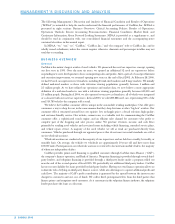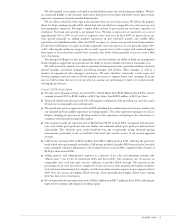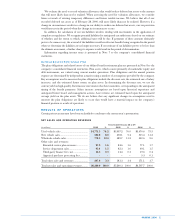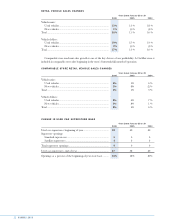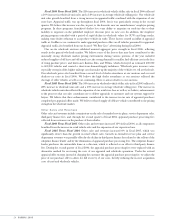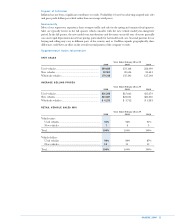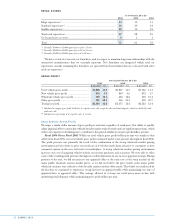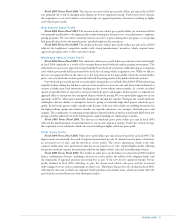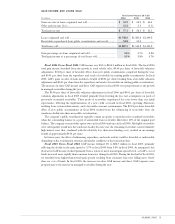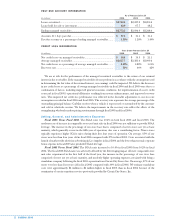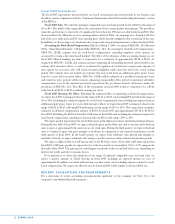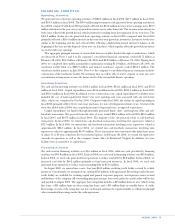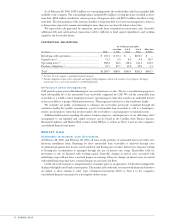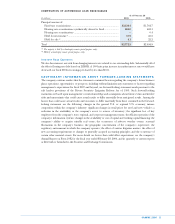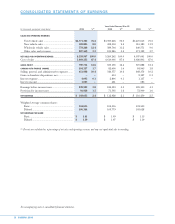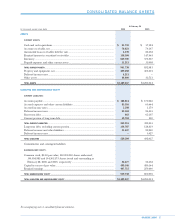CarMax 2006 Annual Report Download - page 30
Download and view the complete annual report
Please find page 30 of the 2006 CarMax annual report below. You can navigate through the pages in the report by either clicking on the pages listed below, or by using the keyword search tool below to find specific information within the annual report.
28
CARMAX 2006
CarMax Auto Finance Income
CAF provides prime automobile financing for our used and new car sales. Because the purchase of an automobile
is traditionally reliant on the consumer’s ability to obtain on-the-spot financing, it is important to our business that
such financing be available to creditworthy customers. While financing can also be obtained from third-party
sources, we believe that total reliance on third parties can create an unacceptable volatility and business risk.
Furthermore, we believe that our processes and systems, the transparency of our pricing, and our vehicle quality
provide a unique and ideal environment in which to procure high-quality automobile loan receivables, both for
CAF and for third-party lenders. CAF provides us the opportunity to capture additional profits and cash flows
from automobile loan receivables while managing our reliance on third-party finance sources.
Years Ended February 28 or 29
(In millions) 2006 % 2005 % 2004 %
Total gain income (1)........................................... $ 77.1 4.1 $ 58.3 3.8 $ 65.1 4.7
Other CAF income(2):
Servicing fee income .................................... 27.6 1.0 24.7 1.0 21.8 1.0
Interest income............................................. 21.4 0.8 19.0 0.8 16.0 0.8
Total other CAF income ................................... 49.0 1.8 43.7 1.8 37.8 1.8
Direct CAF expenses (2):
CAF payroll and fringe benefit expense..... 10.3 0.4 9.0 0.4 8.2 0.4
Other direct CAF expenses ......................... 11.5 0.4 10.3 0.4 9.7 0.5
Total direct CAF expenses................................ 21.8 0.8 19.3 0.8 17.9 0.9
CarMax Auto Finance income (3) ...................... $ 104.3 1.7 $ 82.7 1.6 $ 85.0 1.8
Total loans sold ................................................. $1,887.5 $1,534.8 $1,390.2
Average managed receivables ........................... $2,657.7 $2,383.6 $2,099.4
Ending managed receivables ............................ $2,772.5 $2,494.9 $2,248.6
Total net sales and operating revenues ............ $6,260.0 $5,260.3 $4,597.7
Percent columns indicate:
(1) Percent of loans sold.
(2) Percent of average managed receivables.
(3) Percent of total net sales and operating revenues.
CAF income does not include any allocation of indirect costs or income. We present this information on a
direct basis to avoid making arbitrary decisions regarding the indirect benefit or costs that could be attributed
to this operation. Examples of indirect costs not included are retail store expenses, retail financing commissions,
and corporate expenses such as human resources, administrative services, marketing, information systems,
accounting, legal, treasury, and executive payroll.
CAF originates automobile loans to qualified customers at competitive market rates of interest. The
majority of the profit contribution from CAF is generated by the spread between the interest rates charged to
customers and the related cost of funds. Substantially all of the loans originated by CAF are sold in
securitization transactions. A gain, recorded at the time of securitization, results from recording a receivable
approximately equal to the present value of the expected residual cash flows generated by the securitized
receivables. In a normalized environment, we expect the gains on loans originated and sold as a percent of
loans originated and sold (the “gain spread”) to be in the range of 3.5% to 4.5%.
The reported gains on sales of loans in fiscal 2006 and fiscal 2005 also included the effects of valuation
adjustments, new public securitizations, and the repurchase and resale of receivables in existing public
securitizations. The following table provides information on the aggregate effect of these items on gain income,
loans sold, and gain spread.


